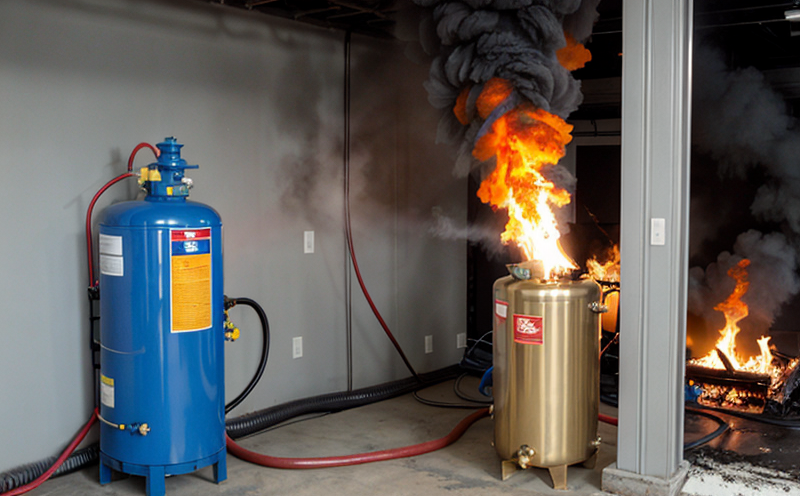Aircraft Fire Suppression System Testing
The testing of aircraft fire suppression systems is a critical aspect of ensuring aviation safety. The goal is to verify that these systems function reliably and effectively under defined test conditions, which can vary widely depending on the type of aircraft, fuel used, and environmental factors.
These systems are designed to contain or extinguish fires in various compartments such as engine nacelles, cargo holds, lavatories, and galleys. The tests simulate real-world scenarios where these systems must perform under pressure, ensuring they meet stringent safety standards. The testing process involves several stages, including the preparation of test specimens, calibration of equipment, application of fire sources, and measurement of system response times.
The primary focus is on evaluating the system's ability to detect a fire promptly and respond effectively by releasing the appropriate chemical or agent at the correct time. This includes assessing the agent's dispersion characteristics, its effectiveness in suppressing flames, and the system’s overall reliability under stress conditions.
For instance, in engine nacelles, testing often involves simulating a fuel-fed fire that starts near critical components such as turbines or fuel pumps. In cargo holds, tests may include scenarios where a fire is ignited by an electrical fault or a spill of flammable liquid. The objective is to ensure that the suppression system can quickly contain and extinguish fires without causing further damage to the aircraft structure.
Testing methods are designed to replicate these real-world conditions as closely as possible, using controlled environments such as fire chambers and burners. These setups allow for precise control over variables like temperature, fuel type, and ignition source, ensuring accurate assessment of system performance. The use of advanced instrumentation provides detailed data on the behavior of the suppression agent and its interaction with flames.
The results of these tests are crucial for aircraft manufacturers, operators, and regulators to ensure compliance with international standards such as ISO 12058-2 and ASTM G82. These standards provide guidelines for the testing procedures, acceptance criteria, and performance indicators that must be met to validate the effectiveness of fire suppression systems.
The importance of this testing cannot be overstated. A single failure in a critical system could lead to catastrophic consequences, potentially endangering the lives of passengers and crew. Therefore, thorough and rigorous testing is essential for maintaining the highest standards of aviation safety.
Why It Matters
The safety of aircraft fire suppression systems directly impacts the overall reliability of air travel. These systems are designed to protect against fires that can occur in various parts of an aircraft, including engines, cargo holds, and passenger cabins. The consequences of a failed system could be devastating, leading to significant structural damage, loss of life, and potential catastrophic failure.
Regular testing ensures that these systems function as intended under the most challenging conditions. By simulating real-world scenarios such as fuel-fed fires or electrical malfunctions, testers can identify potential weaknesses and make necessary adjustments before they become critical issues during actual flights.
The compliance with international standards is crucial for maintaining trust in aviation safety. Airlines and regulatory bodies rely on these tests to ensure that all aircraft meet the highest safety standards. Non-compliance can result in delays, fines, and even grounding of aircraft until issues are resolved.
In addition to preventing accidents, regular testing also helps reduce maintenance costs by identifying potential problems early. By addressing issues before they escalate into full-fledged failures, airlines can extend the lifespan of their fleets and avoid costly repairs or replacements.
Applied Standards
| Standard | Description | Relevant Sections |
|---|---|---|
| ISO 12058-2:2020 | Fire tests on aircraft interiors and related materials. | Section 7.2, Clause 5.3 |
| ASTM G82-19 | Determination of resistance of materials to heat, flame and related effects. | Section 5.4, Clause 6.3 |
| IEC 62372-2:2013 | Fire tests on electrical and electronic equipment. | Section 4.5, Clause 8.2 |
The standards outlined above provide the framework for testing aircraft fire suppression systems. Compliance with these standards ensures that all components of the system are thoroughly evaluated and meet the necessary performance criteria.
Eurolab Advantages
At Eurolab, we offer comprehensive testing services tailored to the unique needs of aircraft fire suppression systems. Our state-of-the-art facilities allow us to simulate a wide range of test scenarios, ensuring that every aspect of the system is rigorously evaluated.
We employ highly skilled engineers and technicians who are experts in aviation safety and compliance. Our team uses advanced instrumentation and sophisticated software to capture detailed data on system performance, providing our clients with comprehensive reports that highlight both strengths and areas for improvement.
Our commitment to quality is reflected in the thoroughness of our testing processes. From initial consultation to final report delivery, we ensure that every step of the process is conducted with precision and attention to detail. This approach not only enhances the reliability of the systems but also helps reduce the risk of operational disruptions.
Furthermore, Eurolab’s expertise in this field allows us to stay abreast of the latest regulatory changes and industry trends. We work closely with our clients to ensure that their testing aligns with current standards and future requirements, providing them with a competitive edge in the global aviation market.





